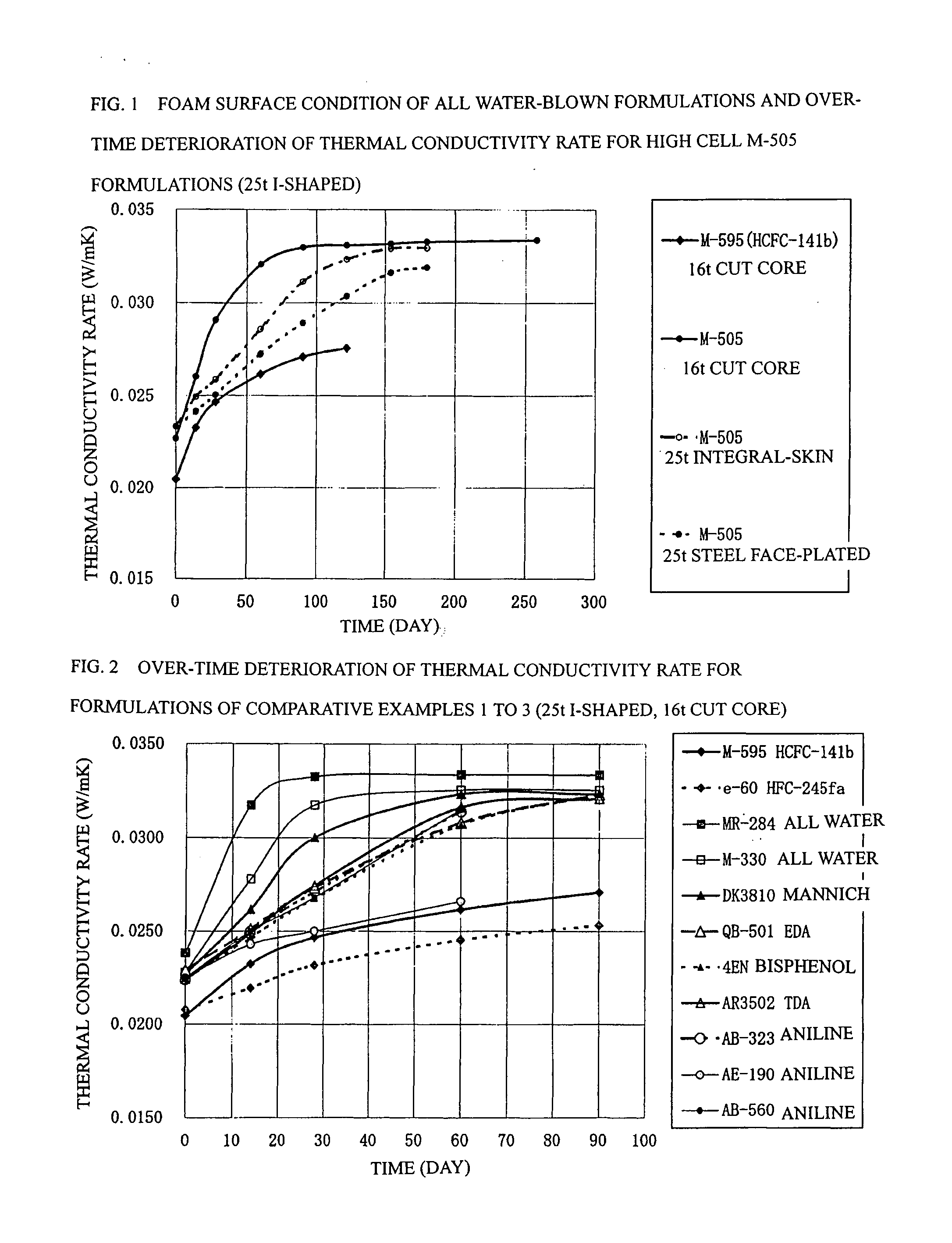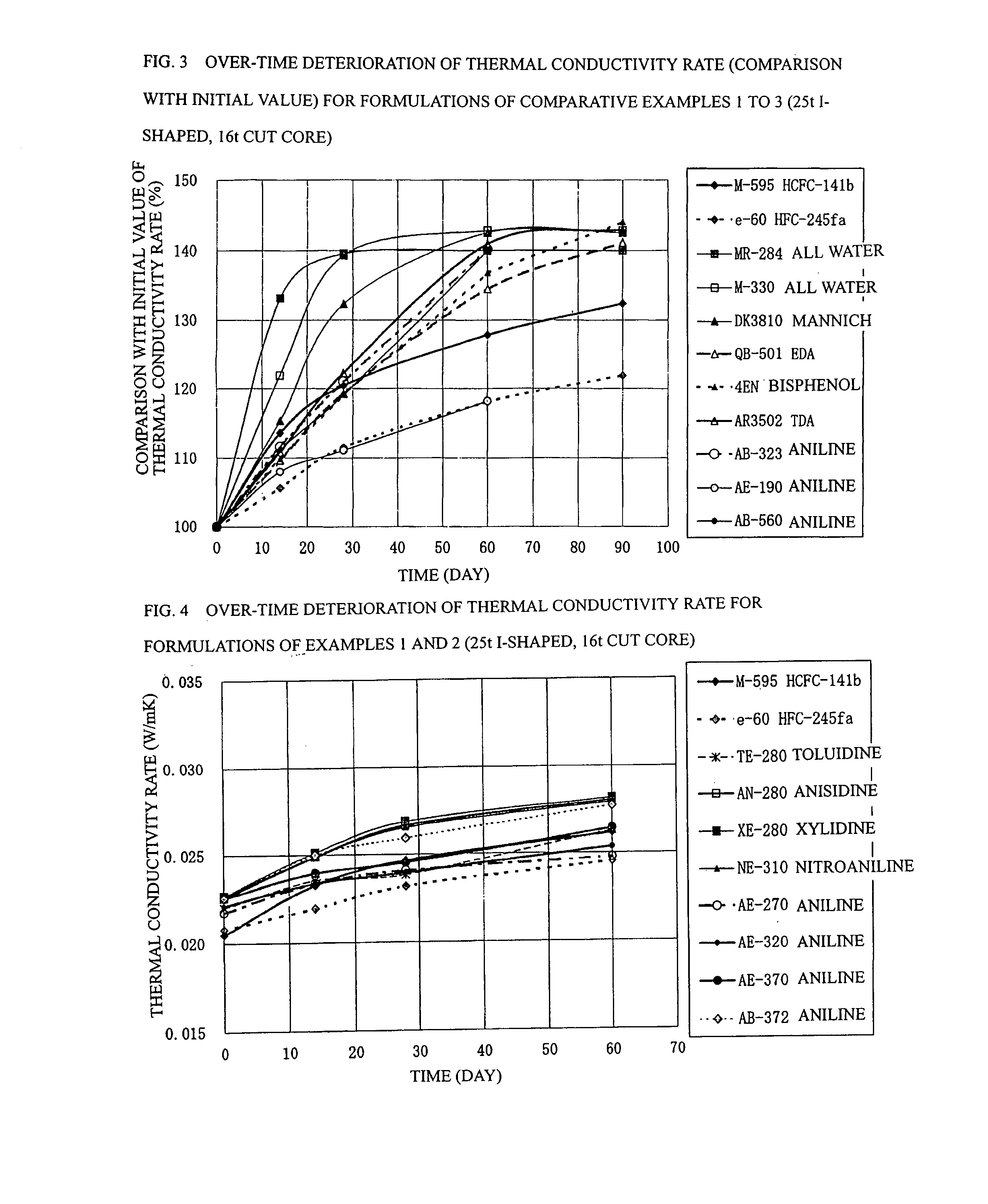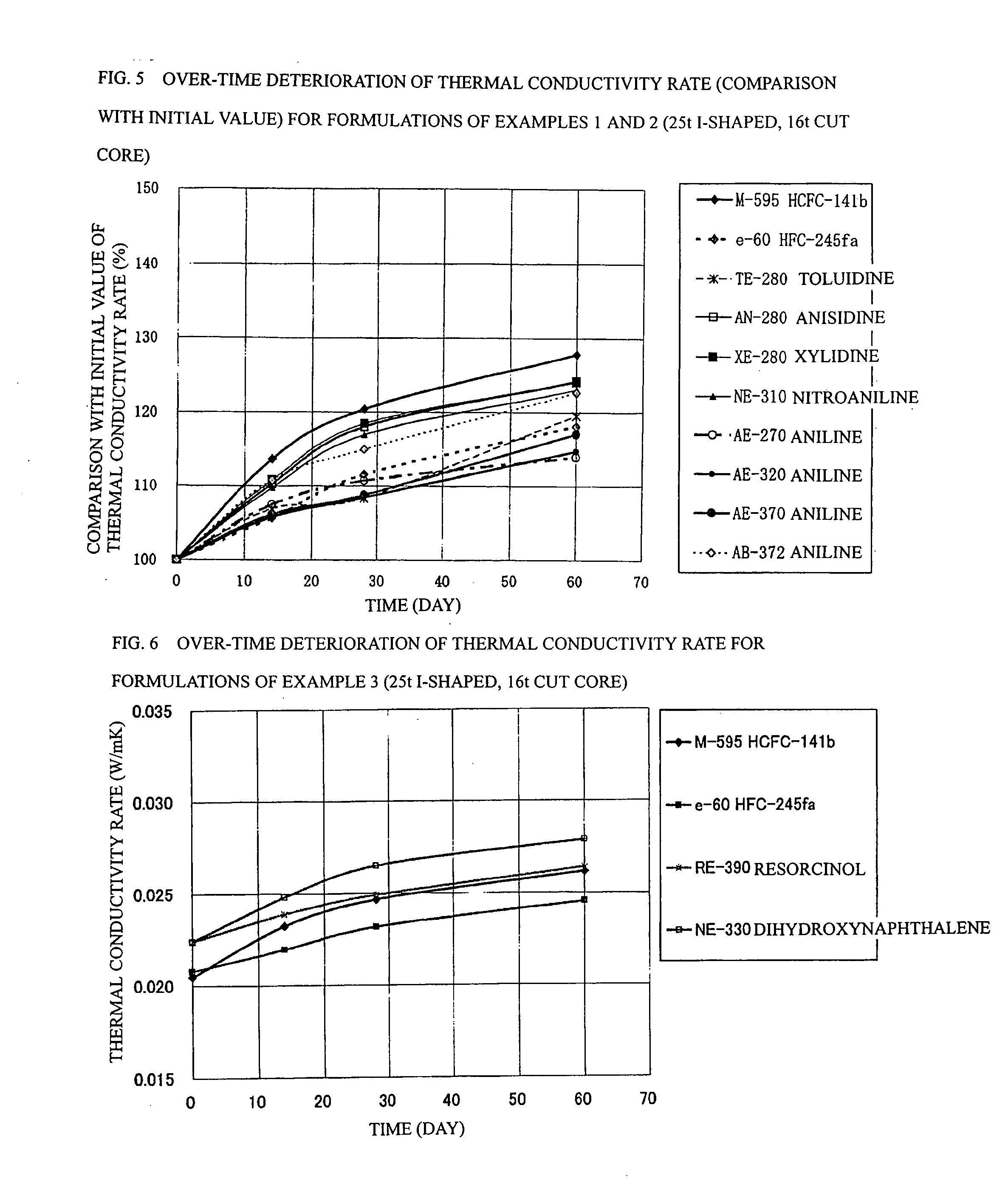Process for Producing Rigid Polyurethane Foam
a polyurethane foam and manufacturing method technology, applied in the field of manufacturing methods of rigid polyurethane foam, can solve the problems of difficult use outside of mass production lines, difficult to penetrate into rigid polyurethane foam, and stop the production of hydrochlorofluorocarbons such as hcfc-141b at the end of 2003, and achieve excellent adhesiveness, little deterioration, and good stability.
- Summary
- Abstract
- Description
- Claims
- Application Information
AI Technical Summary
Benefits of technology
Problems solved by technology
Method used
Image
Examples
example 1
[0084] In example 1 shown in Table 4, panels were prepared using the following formulations: a formulation (12) having a ratio of 5.50 parts by mass of water, 0.61 part by mass of TMHDA, 1.5 part by mass of SZ-1718 manufactured by Dow Corning Toray Co., Ltd. (formerly Nippon Unicar Co., Ltd.), and 197.0 parts by mass of Millionate MR-200 manufactured by Nippon Polyurethane Industry Co., Ltd. based on 100 parts by mass of a Toho polyol TE-280 manufactured by Toho Chemical Industry Co., Ltd. so as to achieve a total mass of 300 g; a formulation (13) having a ratio of 5.36 parts by mass of water, 1.04 part by mass of TMHDA, 1.5 part by mass of SZ-1718, and 189.7 parts by mass of MR-200 based on 100 parts by mass of a Toho polyol AN-280 manufactured by Toho Chemical Industry Co., Ltd. so as to achieve a total mass of 300 g; a formulation (14) having a ratio of 4.36 parts by mass of water, 1.04 part by mass of TMHDA, 1.5 part by mass of SZ-1718, and 189.7 parts by mass of MR-200 based on...
example 2
[0086] In example 2 shown in Table 5, panels were prepared using the following formulations: a formulation (16) having a ratio of 5.60 parts by mass of water, 1.09 part by mass of TMHDA, 1.5 part by mass of SZ-1718 manufactured by Dow Coming Toray Co., Ltd. (formerly Nippon Unicar Co., Ltd.), and 203.1 parts by mass of Millionate MR-200 manufactured by Nippon Polyurethane Industry Co., Ltd. based on 100 parts by mass of a Toho polyol AE-270 manufactured by Toho Chemical Industry Co., Ltd. so as to achieve a total mass of 300 g; a formulation (17) having a ratio of 5.15 parts by mass of water, 1.00 part by mass of TMHDA, 1.5 part by mass of SZ-1718, and 178.2 parts by mass of MR-200 based on 100 parts by mass of a Toho polyol AE-320 manufactured by Toho Chemical Industry Co., Ltd. so as to achieve a total mass of 300 g; a formulation (18) having a ratio of 4.78 parts by mass of water, 0.53 part by mass of TMHDA, 1.5 part by mass of SZ-1718, and 158.9 parts by mass of MR-200 based on ...
example 3
[0092] In example 3 shown in Table 6, panels were prepared using the following formulations: a formulation (20) having a ratio of 5.43 parts by mass of water, 1.06 part by mass of TMHDA, 1.5 part by mass of SZ-1718 manufactured by Dow Coming Toray Co., Ltd. (formerly Nippon Unicar Co., Ltd.), and 193.5 parts by mass of Millionate MR-200 manufactured by Nippon Polyurethane Industry Co., Ltd. based on 100 parts by mass of a Toho polyol RE-390 manufactured by Toho Chemical Industry Co., Ltd. so as to achieve a total mass of 300 g; and a formulation (21) having a ratio of 5.01 parts by mass of water, 0.97 part by mass of TMHDA, 1.5 part by mass of SZ-1718, and 170.6 parts by mass of MR-200 based on 100 parts by mass of a Toho polyol NE-330 manufactured by Toho Chemical Industry Co., Ltd. so as to achieve a total mass of 300 g.
[0093] The formulation (20) in example 3 is a polyol in which ethylene oxide and propylene oxide are subjected to addition to resorcin at a mass ratio of 100 / 0, a...
PUM
| Property | Measurement | Unit |
|---|---|---|
| mass ratio | aaaaa | aaaaa |
| mass ratio | aaaaa | aaaaa |
| temperature | aaaaa | aaaaa |
Abstract
Description
Claims
Application Information
 Login to View More
Login to View More - R&D
- Intellectual Property
- Life Sciences
- Materials
- Tech Scout
- Unparalleled Data Quality
- Higher Quality Content
- 60% Fewer Hallucinations
Browse by: Latest US Patents, China's latest patents, Technical Efficacy Thesaurus, Application Domain, Technology Topic, Popular Technical Reports.
© 2025 PatSnap. All rights reserved.Legal|Privacy policy|Modern Slavery Act Transparency Statement|Sitemap|About US| Contact US: help@patsnap.com



